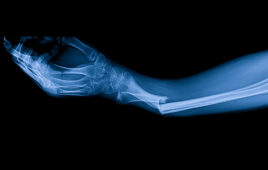
A dermatologist uses a handheld microscope called a dermatoscope to examine skin lesions. Stanford University researchers think a new AI developed could potentially provide another layer of screening.
Stanford University researchers say that they’ve trained a deep learning algorithm to identify skin cancer as well as dermatologists.
The researchers pitted the artificial intelligence against 21 board-certified dermatologists when it came to diagnosing skin lesions. The deep convolutional neural network’s performance was on par with the experts when it came to spotting the most common cancers—keratinocyte carcinomas versus benign seborrheic keratoses. The AI also performed as well as the dermatologists when it came to identifying the deadliest skin cancer—malignant melanomas versus benign nevi.
The researchers’ work is in the January 25 edition of Nature.
The testing involved high-quality, biopsy-confirmed images, but the researchers are hopeful that they can make the AI smartphone compatible.
“Everyone will have a supercomputer in their pockets with a number of sensors in it, including a camera. What if we could use it to visually screen for skin cancer? Or other ailments?” Andre Esteva, a Stanford University graduate student who is a co-lead author of the paper, said in a university news release.
Such screening could make a difference because early detection is so crucial when it comes to skin cancer, according to the researchers. Among the millions of skin cancer cases diagnosed in the U.S. each year, the five-year survival rate is 97% when dermatologists spot the melanoma in its earlier stages. The survival rate drops to 14% for late detection.
Sebastian Thrun, an adjunct professor in the Stanford Artificial Intelligence Laboratory and co-lead author, thinks the research team has hit on an “opportunity to do something great for humanity.”
To create the AI, the Stanford researchers started with a Google-developed algorithm that was already able to analyze 1.28 million images from 1,000 object categories. The algorithm already did a great job telling the difference between cats and dogs, but differentiating between a malignant carcinoma and a benign seborrheic keratosis is a different story. The algorithm needed a database of skin lesion images so that it could train itself to visually diagnose potential skin cancer cases.
“There’s no huge dataset of skin cancer that we can just train our algorithms on, so we had to make our own,” said Brett Kuprel, a Stanford University graduate student and co-lead author of the paper. “We gathered images from the internet and worked with the medical school to create a nice taxonomy out of data that was very messy—the labels alone were in several languages, including German, Arabic and Latin.”
The researchers worked with dermatologists at Stanford Medicine, as well as microbiology and immunology professor Helen M. Blau, to classify the images into what eventually became a database of about 130,000 skin lesion images representing 2,000 different diseases.
While the algorithm’s performance so far has been impressive, it still needs more testing in real-world clinical settings.
“Advances in computer-aided classification of benign versus malignant skin lesions could greatly assist dermatologists in improved diagnosis for challenging lesions and provide better management options for patients. However, rigorous prospective validation of the algorithm is necessary before it can be implemented in clinical practice, by practitioners and patients alike,” said Susan Swetter, a paper co-author, professor of dermatology and director of the Pigmented Lesion and Melanoma Program at the Stanford Cancer Institute.
[Want to stay more on top of MDO content? Subscribe to our weekly e-newsletter.]




